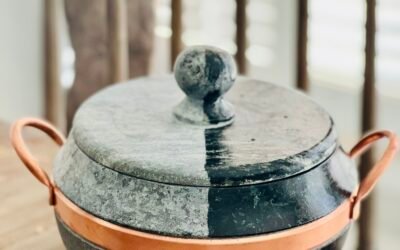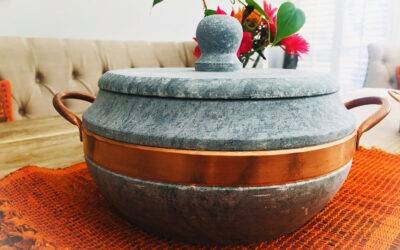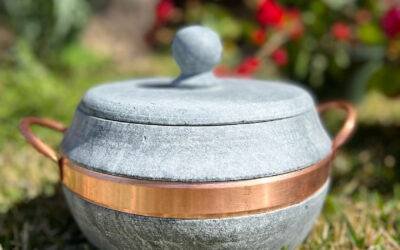
Kalchatti Soapstone Cookware step into the vibrant and aromatic world of South Indian cuisine, where every dish tells a story. From fluffy idli’s and crispy dosas to tangy sambar and rich biryanis, the food culture here is a delightful reflection of the region’s rich heritage. One such culinary gem is the traditional Kalchatti, a unique natural stone cooking pot that has been used for generations to preserve the essence of South Indian traditional cooking technique.
In this article, we delve into the art of using Kalchatti to create the perfect instant mango pickle. The traditional method of blending cut mangoes with a blend of spices and pouring oil over them in a Kalchatti not only gives the pickle a distinct flavor but also enhances its shelf life. We explore the intricacies of this ancient preservation technique, revealing the secrets and techniques passed down through the ages.
Whether you are a fan of South Indian cuisine or simply love the tangy goodness of mango pickle, this article will take you on a flavor-packed journey. Join us as we uncover the traditions, techniques, and flavors that make the Kalchatti Soapstone Cookware an essential tool in every South Indian kitchen. Get ready to tantalize your taste buds and embrace the timeless art of preserving the essence of South India.
The Importance of Preserving Traditional Cooking Methods
In a world where convenience often takes precedence over tradition, it is crucial to recognize the value of preserving traditional cooking methods. These time-honoured techniques not only infuse dishes with authentic flavours but also serve as a link to our cultural heritage. The Kalchatti, a traditional unique natural soapstone cooking pot indigenous to South India, is a prime example of a cooking vessel that has stood the test of time.
The significance of the Kalchatti in South Indian cuisine cannot be overstated. Made from all-natural soapstone, this stone cooking ware is known for its ability to retain heat and distribute it evenly. The non-porous nature of this stone cooking ware allows for slow and steady cooking,resulting in dishes that are rich in flavour and texture. The Kalchatti is not just a cooking utensil; it is a symbol of tradition and a vessel that encapsulates the essence of South Indian cooking.
The Art of Making Instant Mango Pickle
One of the most beloved culinary creations of South India is the mango pickle. Bursting withtangy flavours and aromatic spices, this condiment adds a zing to any meal. While traditional mango pickles require weeks or even months of fermentation, the art of making an instant mango pickle in a Kalchatti is a game-changer.
The process begins with selecting the right mangoes. Firm and slightly unripe mangoes work best for instant pickles, as they retain their texture and absorb the flavours of the spices more effectively. The mangoes are then washed, dried, and cut into small bite-sized pieces. These mango pieces are then mixed with a blend of spices, such as fenugreek powder, red chili powder, turmeric, and asafoetida.
The Benefits of Using a Kalchatti Soapstone Cookware for Pickle Making
Using a Kalchatti for making mango pickle offers several advantages over modern methods.
Firstly, the non-porous nature of this unique and natural Soapstone cooking pot allows the pickle to breathe, facilitating the salt brine fermentation process. This results in a more robust flavor profile and a pickle that is perfectly balanced in taste.
Secondly, the stone cooking ware retains and distributes heat evenly, ensuring that the pickle cooks evenly and at a steady pace. This slow cooking process allows the flavors to meld together, creating a harmonious blend of spices and mango. The heat retention properties of the Kalchatti also help in preserving the pickle for a longer duration, extending its shelf life without compromising on taste.
Lastly, using a Kalchatti adds a touch of nostalgia and authenticity to the pickle-making process. By embracing traditional cooking methods, we honor the culinary traditions of our ancestors and keep the flame of our cultural heritage alive.
Step-by-Step Guide to Making Instant Mango Pickle in a Kalchatti Soapstone Cookware
Now that we understand the significance of the Kalchatti and the benefits it offers for pickle making, let us dive into the step-by-step process of making an instant mango pickle in this traditional natural stone cooking pot.
Preparation: Start by washing and drying the mangoes. Cut them into small bite-sized pieces, discarding the pit.
Spice Blend: In a separate bowl, mix the spices – fenugreek seeds powder, red chili powder, turmeric, and asafoetida. Adjust the spice levels according to your preference.
Process: Heat a Kalchatti on low flame, add about 3 to 4 tablespoons of sesame oil and allow to come to heat. Once hot, add mustard seeds and allow them to splutter. Next add the cut mango pieces and give it a slight mix to coat the mangoes with oil. Follow it by adding the spice mix, sprinkle salt as needed and give it a thorough mix. Turn off the heat. Allow the Kalchatti to cool completely.
Fermentation: Cover and Store the Kalchatti in a cool, dark place between 8 to 24 hours. During this time, the mangoes will begin to release their water and absorb the flavours of the spices, resulting in a tangy and flavorful pickle.
Stirring: After 24hours give the pickle a good stir. This helps in distributing the flavours evenly and ensures that the spices are well-coated on the mango pieces.
Enjoying the Pickle: In hotter climate days, transfer it to a clean, airtight jar and store it in the refrigerator. The pickle can be enjoyed immediately and will continue to develop its flavours over time with a shelf life of up to 5 days. Hence it is advised to make it in smaller batches.

Tips and Tricks for Perfecting Your Pickle Recipe
While making an instant mango pickle in a Kalchatti is an effortless process, there are a few tips and tricks that can help you perfect your pickle recipe.
Choose the Right Mangoes: opt for firm and slightly unripe mangoes, as they hold their shape and absorb flavors better.
Spice Levels: Adjust the spice levels according to your preference. Start with smaller quantities and gradually increase if desired.
Stirring: Stir the pickle during the initial fermentation period and the maturing phase to ensure even distribution of flavors and prevent spoilage.
Storage: Always store the pickle in a clean, airtight jar in the refrigerator. This helps in preserving the pickle longer.
Exploring Other Traditional Recipes That Can Be Made in a Kalchatti Soapstone Cookware
While mango pickle is undoubtedly a favorite, the Kalchatti can be used to create a range of other traditional recipes that capture the essence of South Indian cuisine.
Curries and Stews: The slow and even heat distribution of the Kalchatti makes it ideal for cooking curries and stews. The natural stone cooking pot infuses the dishes with a unique flavor and allows the ingredients to simmer gently, resulting in a rich and flavorful outcome.
Traditional Rice Dishes: The Kalchatti is perfect for preparing traditional rice dishes like biryanis and pulao. The slow cooking process allows the flavors to meld together, resulting in a fragrant and delicious rice dish that is worthy of any feast.
Embracing the Heritage of South Indian Cuisine Through the Use of Traditional Cooking Methods
The Kalchatti is more than just a cooking utensil; it is a vessel that carries the flavours and traditions of South Indian cuisine. By embracing the art of making instant mango pickle in a Kalchatti, we honour the culinary heritage of South India and preserve the essence of its cuisine.
From the slow cooking process that enhances the flavours to the ability to extend the pickles life without compromising taste, the Kalchatti offers numerous benefits. By using traditional cooking methods and utensils like the Kalchatti, we connect with our cultural roots and keep the traditions alive for future generations.
So, why not embark on a culinary adventure and explore the art of preserving the essence of South India through the traditional Kalchatti? Experience the flavours, aromas, and traditions that make South Indian cuisine unique. Let the Kalchatti transport you to the vibrant and aromatic world of South India, one pickle at a time.









0 Comments